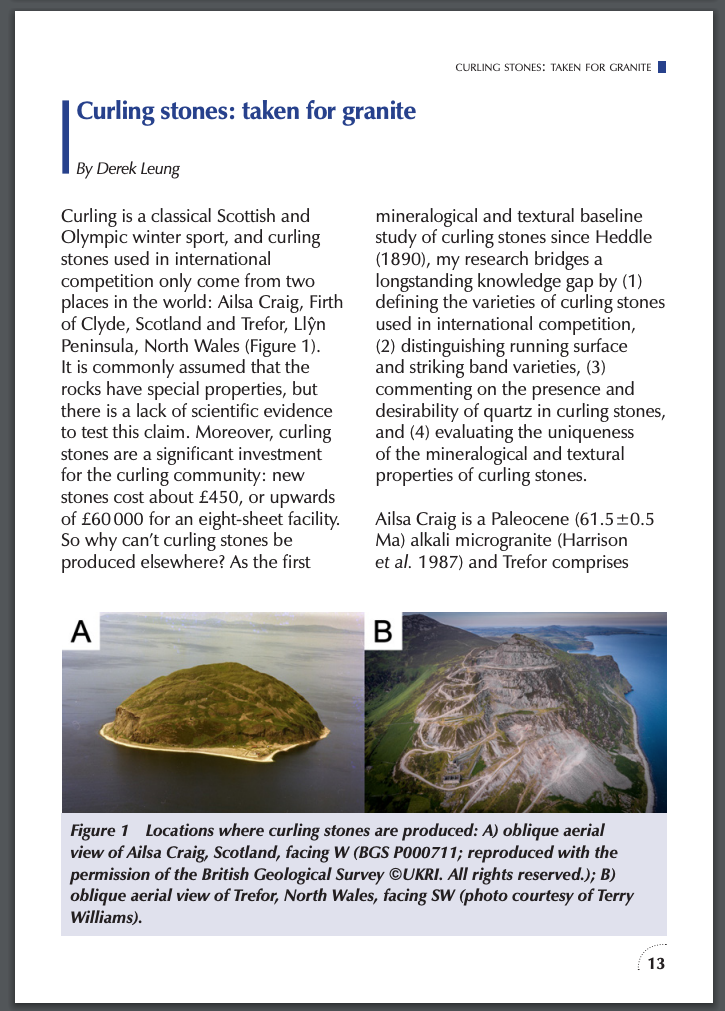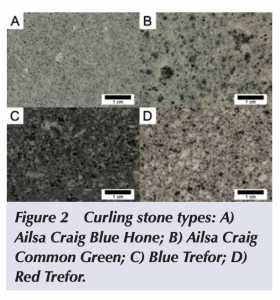Derek Leung is a Canadian graduate student at the University of Edinburgh, Scotland. His research program in Geology is the study of curling stones; specifically the characteristics of a stone’s striking bands. He has sampled a large number of stones of different types, both from Ailsa Craig, Scotland and Trefor, Wales, and is analyzing the wear of each type of stone. His research program is highlighted in a recent issue of the magazine of the Edinburgh Geological Society:
The background for his current work at Edinburgh is from his B.Sc. thesis in Geology from Laurentian University. In his thesis, Derek studied the four common types of granite found in curling stones (Ailsa Craig blue hone, Ailsa Craig common green, Trefor red, and Trefor blue) and looked at their geological makeup, specifically the amount of quartz present in the stone. Here is an excerpt from the introduction to his thesis (abbreviations have been removed to improve clarity):
The World Curling Federation (2018) requires that curling stones have a circumference ≤ 91.44 cm, height ≥ 11.43 cm, and mass between 17.24-19.96 kg. There are two key features of curling stones: (1) the running surface (i.e., ring-like interface between stone and ice surface; Fig. 2A) and (2) the striking band (i.e., the contact area between stones during collision; Fig. 2B). The running surface strongly influences the curling behaviour of the stone (sensu Nyberg et al. 2013) and is subject to ‘pitting’, which is an undesired phenomenon whereby large grains are removed from the running surface (Hansen 1999). Curling ice technicians roughen (i.e., alter the topography of) the running surface to enhance the degree of curl; thus, the topography of the running surface (and evolution thereof) is important for curling stones (S. Jacobson, personal communication, 2018). Toughness is required for striking bands because striking bands accumulate damage through repeated point impacts with other stones, and this limits the lifetime of stones (Cole 1951). Given the uniaxial nature of rock impacts, a potential physical testing analogue is the uniaxial compressive strength (UCS), which is a measure of unconfined rock strength (e.g., Přikryl 2001), although differences between static and impulsive stress are beyond the scope of this study. In either case, the functional properties are directly related to the intrinsic properties of the rock, e.g. the types of minerals present, degree of alteration, the presence of preferred fabrics, and grain-size distribution. [1, pp. 6-7]
In what follows, I’ve taken an excerpt from the abstract of this thesis that highlights his results:
Normalised QAP abundances from petrographic estimates, image analyses, and normative mineralogy indicate that Ailsa Craig samples are dominantly alkali feldspar quartz syenites, Blue Trefor samples are dominantly quartz monzogabbros, and Red Trefor samples lie in the granite and granodiorite fields; no samples are sensu stricto granites. The longstanding belief of the absence and undesirability of quartz in curling stones is challenged by the presence of appreciable (15-25 modal %), unstrained quartz in all curling stone samples. Between curling stone types, the degree of alteration is variable (< 5-50 modal % secondary minerals, including secondary patchy albite), suggesting that the degree of alteration is of secondary importance to curling stone performance. Weak primary preferred fabrics suggest variable anisotropy, the significance of which is unknown. Ailsa Craig Blue Hone is mineralogically and chemically similar to Ailsa Craig Common Green but is strongly contrasted by texture: Ailsa Craig Common Green has a larger grain-size distribution and greater proportion of medium-grained minerals (~20 modal %), owing to the presence of drusy mafic minerals and quartz, and stronger, patchier albite alteration; in Ailsa Craig Blue Hone samples, mafic minerals and quartz are interstitial and disseminated. This textural difference reflects functional differences between striking bands (Ailsa Craig Common Green) and running surfaces (Ailsa Craig Blue Hone). Striking band materials (Ailsa Craig Common Green, Blue Trefor, and Red Trefor) have larger ranges in grain-size distribution and greater proportions of medium-grained phenocrysts/druses compared to running surface materials (Ailsa Craig Blue Hone). [1, pp. 2-3]
Derek’s work represents an advance over prior studies. The poor qualities of Ailsa Craig blue hone granite as a striking band are well known; Derek’s work, and his study of hundreds of samples, looks at the physical properties of the granite being used in the hopes of extending the life of existing stones. A natural extension of this work would be studying the “drag effect” of curling stones with striking bands of particular characteristics. Another goal is to quantify the characteristics necessary in order to assess the suitability of another source of granite for curling stones.
You can assist Derek with his research by contributing to his Go Fund Me page.
My sincere thanks to Rachel Dobbs, a Wilfrid Laurier University graduate student, and a fellow member at Elmira & District Curling Club, for sending Derek’s story my way.
[1] Derek D. Leung, Andrew M. McDonald, and Rémy S. Poulin (April 2019). Taking Rocks For Granite: An Integrated Mineralogical, Textural, and Petrographic Baseline Of Curling Stones Used in International-Level Competition. B.Sc. thesis, Laurentian University, Sudbury, Ontario.
[2] Derek Leung (Spring 2020). Curling stones: taken for granite. The Edinburgh Geologist 67, pp. 13-16. The Edinburgh Geological Society, ISSN 0265-7244. Available online here.

